Plant diseases present significant challenges for vegetable growers. They can be difficult to diagnose and hard to control, and have significant impacts on quality and yields. Seed-borne diseases are especially challenging, because the earlier in the plant’s lifecycle the pathogen comes in contact with the crop, the greater the potential for serious disease problems to develop.
“We had been growing beautiful parsley for 20 years, then one year our parsley suddenly came up with spots,” says Sandy Arnold of Pleasant Valley Farm in upstate New York. “We had all kinds of tests done, but couldn’t narrow down the problem. The same thing happened to our spinach, which is a very important crop for us, even though we were using RootShield drenches and everything else we could think of. The plants just weren’t healthy and vigorous.”
While most seed companies are doing all they can to prevent and control seed-borne diseases, pathogens can still slip through — even on conventionally treated seed. Even though seed suppliers and resellers test for a wide variety of diseases, tests are not available for all seed-borne diseases — and the seeds you actually plant are not tested, as it is a destructive process performed on a representative sample of the seed lot.
“Don’t assume that any treatment will treat every disease,” says Johnny’s Selected Seeds’ Bonita Nichols. “That’s just a dangerous assumption.” Most seed treatments are fungicides, and not effective against bacteria or viruses. In addition, treatments applied to the surface of the seed, organically approved or not, treat only the surface of the seed, and thus cannot reach pathogens that have taken up residence inside.
Further, Meg McGrath, of Cornell University’s Long Island Horticultural Research and Extension Center, notes, “If you’re into locally adapted seeds and exchanging seeds with other growers, or buying from a very small seed company, you might want to assume that the potential exists for seed-borne diseases.”
 Pictured above: Two water baths are required for hot water seed treatment. The first bath is in the Carolina model on the right, which brings the seeds up to 100°F. Next, seeds are placed in the water bath on the left, which is set for the temperature specified for that crop, as shown in the table on page 4. Precision instruments are critical; because of the expense, many growers borrow them from Cooperative Extension or go together on the purchase.
Pictured above: Two water baths are required for hot water seed treatment. The first bath is in the Carolina model on the right, which brings the seeds up to 100°F. Next, seeds are placed in the water bath on the left, which is set for the temperature specified for that crop, as shown in the table on page 4. Precision instruments are critical; because of the expense, many growers borrow them from Cooperative Extension or go together on the purchase.
Fortunately, for many small-seeded crops, hot-water treating seeds is something that can be managed at the individual farm level. “When we started using a hot water bath to treat parsley seeds,” Sandy told me, “It cleared up the problems just like that. The same thing happened to our spinach — when we started hot-water treating our spinach seeds, we suddenly had the most gorgeous spinach again. In my opinion, hot water treatment has been 100 percent effective for these crops.” Pleasant Valley Farm has also found hot water treatment to be effective for helping to reduce Alternaria in their cabbage and Brussels sprouts crops.

After the seeds have been in hot water for the prescribed time, they are removed and placed to dry in a home food dehydrator, right, with only the fan running. Photos by Sandy Arnold.
Hot water treatment works for a wide variety of small seeds, including brassicas, tomatoes, eggplants, peppers, onions, carrots, parsley, and lettuce. Some growers are also using it on garlic cloves and sweet potato slips.

The hot water treatment works by holding seeds at a strictly prescribed temperature for a set period of time. It’s analogous to the functioning of a fever – you heat the seed as much as you can to kill the disease organisms, but not so much that you kill the seed. There is a small margin between the temperature and the time of exposure needed to kill pathogens and the treatment conditions that will kill the seeds. This margin varies by crop, so it’s important to follow the proper treatment protocols, including the time and temperature variables shown in the table at right.
Seeds that are pelleted or primed should not be treated with hot water baths. It may also be a bad idea to hot water treat old seed, or seeds that have already been hot water treated. Hot water treatments aren’t always listed on the seed packet, so you should check with your seed source about each batch of seeds that you are preparing to treat.
You should only treat the seeds that you plan to plant in the current year. “Hot water treatment accelerates the physiological aging process,” says Meg McGrath. “But it’s also priming the seed, so you can actually increase germination rates in some crops, especially when planting is done right after treatment.”
Treating the seeds
Hot water treatment isn’t a long process; it takes longer to set up the equipment and get the seeds ready than it does to actually do the treatment. Many growers choose to do this as a group, either to reduce the cost of equipment or to share equipment owned by Cooperative Extension. Meg commented that getting together with a group of growers to treat seeds almost feels like an afternoon of quilting; Sandy Arnold noted that her local growers group often hot-water treats seeds as part of other meetings.
 Sandy and Paul Arnold make envelopes of fiberglass window screening for treating seeds. Photo by Sandy Arnold.
Sandy and Paul Arnold make envelopes of fiberglass window screening for treating seeds. Photo by Sandy Arnold.
The first step is to wrap the seeds loosely, so that the hot water can flow around the seeds freely. The Arnolds have found that fiberglass window screen makes the best envelopes. Cut the screen into large enough pieces so that the seed lot can fit inside, then fold a piece in half, roll the edges, and staple closed on two sides so that seeds may still be inserted on the open side. Insert the seeds, and add a plastic plant tag marked with a permanent marker to identify the seeds — Sandy marks the label and the seed packet each with just a letter, rather than writing out the complete seed information — then fold over the remaining side and close with one or more paperclips; other sources recommend stapling the fourth side of the packet as well, to avoid any problems with paperclips popping off.
You can also use old stockings or cheesecloth, especially for very small-seeded crops like small tomato seeds and turnips, but the screen allows you to leave the seeds in the packet if you dry them in a dehydrator at the end of the process.
Seeds are placed first into a 100º F bath for 10 minutes to pre-warm them. Sandy uses a Carolina Water Bath model 216248, which holds about two gallons of water, for this step. It is important to have the water temperature completely stabilized before warming the seeds; a precision laboratory thermometer is an important tool for this process.
Next, seeds are placed in a second hot water bath at the treatment temperature for a precise amount of time. Again, it is important to have the water temperature completely stabilized before adding the pre-warmed seeds. An aquarium pump and an air stone can be added to agitate the water. Sandy uses silverware to weight the packets down; you want them in the middle of the water bath, not on the top or the bottom. Meg uses bolts, nuts, or coins added to the packets.
Sandy uses a Precision 280 water bath for the treatment step — it’s a digital microprocessor-controlled, very precise tool that heats about a gallon of water. “Treatment can be done on a stove top,” says Meg. “A good thermometer is key, and you’ll spend a lot more time fiddling with the temperature.” The stove top method is probably best done with hardy seeds like tomatoes, rather than with more sensitive crops like parsley and spinach.
At the end of the treatment time, seeds are removed from the bath and put in a big bowl with cold water for five minutes to stop the heating action.
Drying the seeds is a critical step, and must be done thoroughly to maintain the best germination and vigor. Many people simply spread the seeds out to dry, but Sandy prefers to leave the seeds in the fiberglass screen packets and place them in a food dehydrator, with only the fan running, not the heating element.
“Just be sure to leave the seeds in the envelopes,” Sandy says, speaking from experience. “Otherwise, you end up with seeds all over the place.” If you made your seed envelopes big enough, the seeds should dry in a dehydrator without needing to move them around, but if you find they aren’t getting dry, take the time to flip them around. For small-seeded crops like brassicas, expect drying to take one to two hours; for larger seeds like spinach, expect six to eight hours, or even more. A small packet of silica gel placed in the final storage container with your seeds can help ensure that they are thoroughly dry.
Hot water treatment doesn’t provide complete control of diseases, but it can be an important and easily controlled part of an integrated disease management program that includes rotation, sanitation, and treatment of diseases that appear in the field.
Sourcing equipment
The equipment for hot water treating seeds is expensive – it would be easy to spend $1,500 for a treatment setup. But one saved crop could easily pay for the equipment. Sandy Arnold notes, “If I didn’t already have access to the equipment through extension, I would definitely buy it.”
Fortunately for small growers, you only need to use the equipment once or twice a year, and its use is completely weather independent. This makes it ideal for sharing, whether as a shared purchase among a group of growers, or through a cooperative extension or farmer network purchase. In many states in the northeast, area extension offices already have the equipment described above, and host seed treatment days or provide seed treatment services.
Chris Blanchard assists farmers, food businesses, and non-profits to improve, create, and implement systems to improve profitability and quality of life. He has worked in farming for the past 24 years, managing farms and other operations around the country. As the owner and operator of Rock Spring Farm since 1999, Chris raised twenty acres of vegetables, herbs, and greenhouse crops, marketed through a 200-member year-round CSA, food stores, and farmers markets. His newsletter, The Flying Rutabaga, can be found at www.flyingrutabagaworks.com.

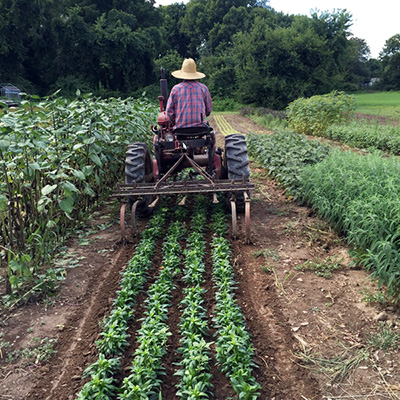

 If you’ve been a subscriber to Growing For Market (or even if you haven’t), you’re probably familiar with the many advantages of no-till agriculture. No-till methods can reduce a farm’s carbon footprint, promote complex soil biology, and preserve and build organic matter.
If you’ve been a subscriber to Growing For Market (or even if you haven’t), you’re probably familiar with the many advantages of no-till agriculture. No-till methods can reduce a farm’s carbon footprint, promote complex soil biology, and preserve and build organic matter.
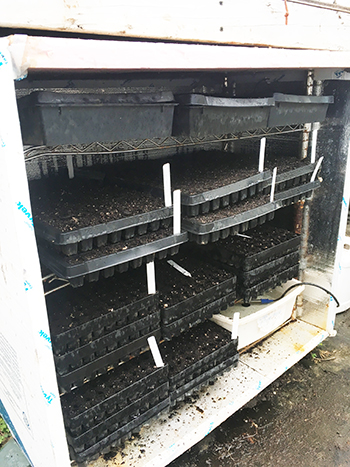 Until two years ago I was germinating all seedlings in greenhouses using almost exclusively bottom heat from electric heat mats. At my current farm we only had space for about 8-10 trays on our two mats and we definitely noticed differences in the germination (and presumably the heat the mats were providing) on the edges of our trays.
Until two years ago I was germinating all seedlings in greenhouses using almost exclusively bottom heat from electric heat mats. At my current farm we only had space for about 8-10 trays on our two mats and we definitely noticed differences in the germination (and presumably the heat the mats were providing) on the edges of our trays.

 Over the last three years, I’ve been involved with a new experimental farm in my province of Quebec. At my farm, La Ferme de Quatre Temps, I was asked to design and create a training farm where some of the strategies described in my book
Over the last three years, I’ve been involved with a new experimental farm in my province of Quebec. At my farm, La Ferme de Quatre Temps, I was asked to design and create a training farm where some of the strategies described in my book 

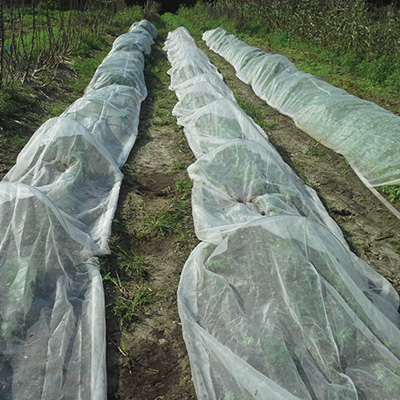


 Have you ever lost precious seedlings in your greenhouse to frost? How about tossing a flat or two out due to heat stress or a missed watering? Or better still, stared at a tray of seeds that won’t germinate, with smoke coming out of your ears, because you’re sure someone (not you!) mis-watered them at a critical moment? Have you ever shrugged to yourself reading the growing instructions on a seed packet that says “Germinates best at 70 Fahrenheit” while standing in your 85-90 degree greenhouse? You’ve started to look into a germination chamber to solve some of these issues, but they look pricey and have limitations like not being able to handle as many flats as you’d like to start at once.
Have you ever lost precious seedlings in your greenhouse to frost? How about tossing a flat or two out due to heat stress or a missed watering? Or better still, stared at a tray of seeds that won’t germinate, with smoke coming out of your ears, because you’re sure someone (not you!) mis-watered them at a critical moment? Have you ever shrugged to yourself reading the growing instructions on a seed packet that says “Germinates best at 70 Fahrenheit” while standing in your 85-90 degree greenhouse? You’ve started to look into a germination chamber to solve some of these issues, but they look pricey and have limitations like not being able to handle as many flats as you’d like to start at once.

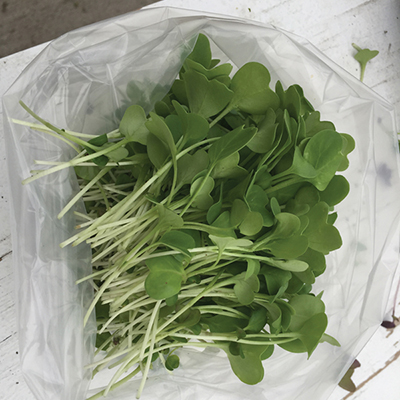


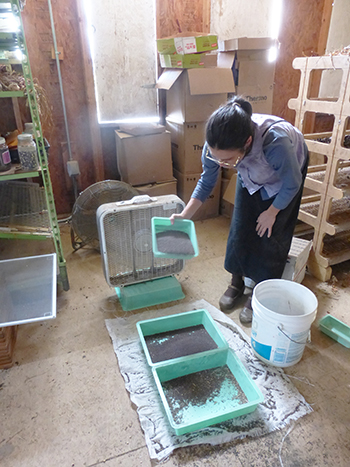 Last month I wrote about
Last month I wrote about 
